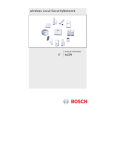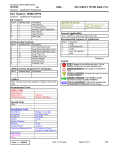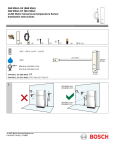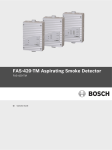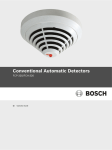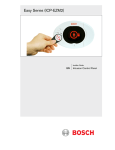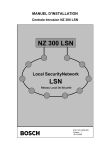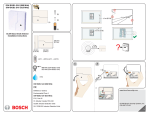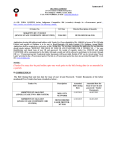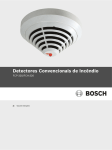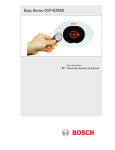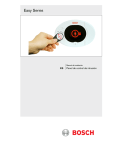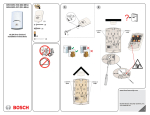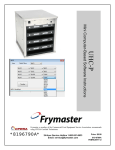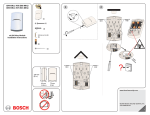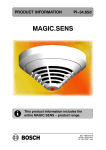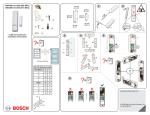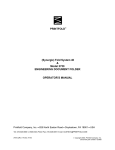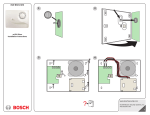Download Bosch ISW-BIT1-HAX WLSN INSTALLATION
Transcript
wireless Local SecurityNetwork Reference Guide EN wLSN wLSN | Reference Guide | Trademarks Trademarks Pet Friendly® is a registered trademark of Bosch Security Systems in the United States. 2 Bosch Security Systems, Inc. | 3/07 | F01U009440-01 wLSN| Reference Guide | Contents Contents 1.0 Using this Document ..........................................................7 2.0 2.1 2.2 2.3 2.4 2.5 2.6 General Installation............................................................9 Installation Considerations........................................................ 9 General Specifications .............................................................. 9 Installation Procedure ............................................................. 10 Site Testing (RFSS Mode) ...................................................... 11 Defaulting a wLSN Device (Undiscovered State) .................... 18 Battery Requirements ............................................................. 19 3.0 wLSN Installation Tool ...........................................21 4.0 4.1 4.2 wLSN Hub ...........................................................23 wLSN Hub Switches ............................................................... 24 wLSN Hub LED....................................................................... 25 5.0 5.1 5.2 wLSN PIR and Dual Motion Detectors ..............26 Sensitivity Settings.................................................................. 26 Walk Testing........................................................................... 28 6.0 6.1 wLSN Door-Window Contact ...................................30 Supported Wiring Configurations ............................................ 31 7.0 wLSN Recessed Door-Window Contact ..............33 8.0 wLSN Mini Door-Window Contact...........................35 Bosch Security Systems, Inc. | 3/07 | F01U009440-01 3 wLSN | Reference Guide | Contents 9.0 9.1 9.2 wLSN Inertia Detector .............................................36 Sensitivity Settings.................................................................. 37 Test Mode............................................................................... 38 10.0 10.1 10.2 wLSN Key Fob........................................................39 Key Fob Buttons ..................................................................... 40 LED......................................................................................... 40 11.0 wLSN Relay Module...............................................41 12.0 wLSN Siren (Indoor) ...............................................42 13.0 13.1 13.2 13.3 13.4 13.5 13.6 13.7 wLSN Smoke Detector ......................................43 Battery Replacement .............................................................. 44 Smoke Test............................................................................. 44 Sensitivity Test........................................................................ 45 Test/Silence Button................................................................. 45 LED......................................................................................... 46 Cleaning the Detector and Replacing the Optical Chamber .... 46 Returning the Smoke Detector to an Undiscovered State ....... 48 14.0 14.1 14.2 14.3 14.4 14.5 wLSN Glassbreak Detector..................................50 Installation Considerations ...................................................... 52 Sensitivity Settings.................................................................. 53 Testing.................................................................................... 54 Low Battery Indication............................................................. 57 Wall Tamper Tab .................................................................... 57 4 Bosch Security Systems, Inc. | 3/07 | F01U009440-01 wLSN| Reference Guide | Figures Figures Figure 1: Figure 2: Figure 3: Figure 4: Figure 5: Figure 6: Figure 7: Figure 8: Figure 9: Figure 10: Figure 11: Figure 12: Figure 13: Figure 14: Figure 15: Figure 16: Figure 17: Figure 18: Figure 19: Figure 20: Figure 21: Figure 22: Device Tamper Switches.................................................. 13 wLSN Installation Tool...................................................... 22 Switches........................................................................... 24 wLSN Hub LED ................................................................ 25 Decreasing and Increasing Microwave Range ................. 27 Walk Test ......................................................................... 28 Single 1 kΩ, 2.2 kΩ, or 3.65 kΩ EOL Resistor Option ...... 31 1.5 kΩ or 2.2 kΩ EOL Resistor and Tamper Option ......... 32 Zone-Doubled 1 kΩ or 2.2 kΩ EOL Resistor Option ......... 32 Recessed Door-Window Contact Tamper Switch ............. 34 Mini Door-Window Contact Tamper Switch ...................... 35 Sensor Adjustment ........................................................... 37 Wiring Route .................................................................... 37 Key Fob Buttons and LEDs .............................................. 39 wLSN Smoke Detector ..................................................... 44 Remove the Detector Cap ................................................ 46 Remove the Detector Cap ................................................ 47 Returning the Smoke Detector to Undiscovered Mode..... 49 Glassbreak Front Layout .................................................. 51 Glassbreak Sensitivity Switches ....................................... 53 13-332 Sound Sensor Tester ........................................... 54 Wall and Cover Tamper Switches .................................... 57 Bosch Security Systems, Inc. | 3/07 | F01U009440-01 5 wLSN | Reference Guide | Tables Tables Table 1: Table 2: Table 3: Table 4: Table 5: Table 6: Table 7: Table 8: Table 9: Table 10: Table 11: Table 12: Table 13: Table 14: Table 15: Table 16: Table 17: Table 18: Table 19: Table 20: Table 21: Table 22: Table 23: Table 24: 6 wLSN Products and Instructions......................................... 8 General Specifications........................................................ 9 LED Flash Patterns in RFSS Mode .................................. 13 Interpreting Mode 2 Display.............................................. 16 Battery Requirements....................................................... 20 Installation Tool Specifications ......................................... 21 wLSN Installation Tool LED Status ................................... 21 wLSN Hub Specifications ................................................. 23 wLSN Hub LED Displays .................................................. 25 wLSN PIR and Dual Motion Detectors Specifications ....... 26 Walk Test LED Indications................................................ 29 wLSN Door-Window Contact Specifications ..................... 30 Recessed DW Contact Specifications and Required Tools33 wLSN Mini DW Contact Specifications ............................. 35 Inertia Detector Specifications .......................................... 36 wLSN Key Fob Specifications........................................... 40 Relay Module Specifications............................................. 41 Siren Specifications .......................................................... 42 Smoke Detector Specifications......................................... 43 Smoke Detector Sensitivity Conditions ............................. 45 LED Status ....................................................................... 46 Glassbreak Detector Specifications .................................. 50 Glassbreak Sensitivity Settings ........................................ 53 Icons and Symbols ........................................................... 59 Bosch Security Systems, Inc. | 3/07 | F01U009440-01 wLSN | Reference Guide | 1.0 Using this Document 1.0 Using this Document This document contains the basic information that a trained installer needs to install the wireless Local SecurityNetwork (wLSN). It supplements the documents listed in Table 1 on page 8. This reference guide contains: • A description of the wLSN general installation procedure (Section 2.0 General Installation on page 9). • Device-specific installation procedures (Sections 3.0 through 14.0 starting on page 21). • A description of the icons used in the wLSN documentation (Appendix on page 59). Use this document along with the control panel’s documentation and each device’s installation instructions to complete the installation process. When you see the following logo in the wLSN installation instructions listed in Table 1 on page 8, refer to the appropriate section in this document. Bosch Security Systems, Inc. | 3/07 | F01U009440-01 7 wLSN | Reference Guide | 1.0 Using this Document Table 1: wLSN Products and Instructions Product Document Part Number ISW-BIT1-HAX ISW-BIT1-HBX ISW-BIT1-HCX ISW-BHB1-WXA ISW-BHB1-WXB ISW-BHB1-WXC ISW-BPR1-W13PX wLSN Installation Tool Installation Instructions F01U008748 wLSN Hub Installation Instructions F01U500915 wLSN PIR Motion Detector Installation Instructions wLSN Dual Motion Detector Installation Instructions F01U500908 wLSN Door-Window Contact Installation Instructions wLSN Recessed Door-Window Contact Installation Instructions wLSN Mini Door-Window Contact Installation Instructions wLSN Inertia Detector Installation Instructions wLSN Key Fob Installation Instructions wLSN Relay Module Installation Instructions wLSN Siren Installation Instructions wLSN Smoke Detector Installation Instructions wLSN Glassbreak Installation Instructions Easy Series Installer Guide F01U500909 ISW-BDL1-W11PGX ISW-BDL1-W11PHX ISW-BDL1-W11PKX ISW-BMC1-S135X ISW-BMC1-R135X ISW-BMC1-M82X ISW-BIN1-S135X ISW-BKF1-H5X ISW-BRL1-WX ISW-BSR1-WX ISW-BSM1-SX ISW-BGB1-SAX ICP-EZM2 8 F01U500901 F01U011878 F01U011876 F01U011980 F01U001565 F01U009264 F01U009265 F01U012075 F01U027173 F01U025147 Bosch Security Systems, Inc. | 3/07 | F01U009440-01 wLSN | Reference Guide | 2.0 General Installation 2.0 General Installation 2.1 • • • • • • Installation Considerations wLSN devices are intended only for indoor, dry applications. Mount wLSN devices on flat, rigid surfaces. Some devices can be optionally corner mounted as indicated in the installation instructions. Avoid mounting wLSN devices in areas with large metallic objects, electrical panels (for example: control panel or fuse box) or electric motors. They might reduce the radio-frequency (RF) range of a wLSN device. Avoid installing the devices where excessive humidity or moisture, or temperatures outside of the acceptable operating range exist. Wire all devices according to their specifications. wLSN devices use batteries of varying types. When installing batteries, observe safety and polarity recommendations as indicated in the documentation for those products. Refer also to Section 2.6 Battery Requirements on page 19. 2.2 General Specifications Table 2: General Specifications Humidity range Frequency band 0% to 95% 868 to 869 MHz European Security Band Bosch Security Systems, Inc. | 3/07 | F01U009440-01 9 wLSN | Reference Guide | 2.0 General Installation 2.3 Installation Procedure When installing a wLSN Network, you must plan your installation based on the control panel and wLSN specifications, and the radio-frequency signal strength (RFSS) between remote devices and the wLSN Hub. The wLSN installation procedure consists of two parts: 1. Site testing for radio-frequency signal strength (RFSS) between remote devices and the wLSN Hub. 2. Mounting all wLSN devices. Refer to the control panel’s documentation for detailed instructions on wLSN programming and device set up. 10 Bosch Security Systems, Inc. | 3/07 | F01U009440-01 wLSN | Reference Guide | 2.0 General Installation 2.4 Site Testing (RFSS Mode) Before permanently installing any wLSN device, verify that the radio-frequency signal strength (RFSS) between the planned device location and the planned wLSN Hub location is acceptable. CAUTION: If you have wireless devices that you will not immediately install, reinsert the battery tabs or remove the batteries to prevent battery depletion. There are two ways to verify that devices can communicate with the wLSN Hub: • Use the wLSN Hub with the remote device operating in RFSS mode • Use the wLSN Hub with the Installation Tool 2.4.1 Preparing the wLSN Hub for Site Testing and RFSS Mode If the hub is already part of a system, note the original switch settings on the wLSN Hub before setting the switches for RFSS mode. 1. Rotate the enclosure locking mechanism on the wLSN Hub to the unlocked position and remove it from the base. 2. Set Switch S1 to 9 and Switch S2 to 2 to enable RFSS mode. This disables normal operation. Refer to Section 4.1 wLSN Hub Switches on page 24 for more information on switch settings. 3. Set Switch S3 to a value of 0 to 4, based upon the RF power level or EN50131 security grade you wish to use: - 0= Maximum power - 1= 3 dB lower than maximum (Security Grade 1) - 2= 6 dB lower than maximum (Security Grade 2) - 3= 9 dB lower than maximum (Security Grade 3) - 4= 12 dB lower than maximum (Security Grade 4) Refer to individual device’s specification for their EN50131 classification. Bosch Security Systems, Inc. | 3/07 | F01U009440-01 11 wLSN | Reference Guide | 2.0 General Installation You must test the devices at the same EN50131 Security Grade at which the control panel discovers the devices. 4. Find a suitable location for the hub base and apply power by either connecting it to the control panel (refer to the control panel’s installation instructions), or temporarily connecting a 9 VDC to 12 VDC battery. 5. Insert the wLSN Hub back into the base. Rotate the enclosure locking mechanism to the locked position. 6. Proceed to the appropriate procedure: - Section 2.4.2 RFSS Testing Between wLSN Hub and Device - Section 2.4.3 RFSS Testing Between wLSN Hub and Installation Tool on page 14 You must use the Installation Tool with the wLSN Smoke Detector. You cannot determine RFSS with the detector itself. 2.4.2 RFSS Testing Between wLSN Hub and Device 1. Take the device being tested to its planned mounting location. 2. Remove and re-insert the batteries of the device, then quickly press and release the tamper switch button (refer to Figure 1 on page 13) four times to enter RFSS mode. You must enter RFSS mode within 10 sec of re-inserting the batteries. When RFSS mode is enabled, the LED lights steadily for 5 sec, then flashes. 12 Bosch Security Systems, Inc. | 3/07 | F01U009440-01 wLSN | Reference Guide | 2.0 General Installation Figure 1: Device Tamper Switches 2 1 1- Button style tamper switch 2- Lever style tamper switch 3. Hold the device at the planned mounting location. 4. Determine if the RF signal strength is acceptable by observing the device’s LED flash pattern (Table 3). The flash pattern appears for 10 min. Table 3: LED Flash Patterns in RFSS Mode LED Flash Pattern Flashes at 1 sec intervals Flashes rapidly (0.2 sec interval) Signal Strength No packets received or unacceptable signal strength condition. Acceptable signal strength If the RFSS is unacceptable, reposition the device until an acceptable location is found. If necessary, reposition the wLSN Hub. 5. Repeat this procedure for each device you are testing. When you finish testing the devices, return the wLSN Hub’s switches to their original position. Bosch Security Systems, Inc. | 3/07 | F01U009440-01 13 wLSN | Reference Guide | 2.0 General Installation Reset the wLSN Hub’s DIP switches to their original settings to exit RFSS mode. Refer to Section 2.4.1 Preparing the wLSN Hub for Site Testing and RFSS Mode on page 11. To cause a device to exit RFSS mode, remove the device's batteries and re-insert them. Devices automatically exit RFSS mode after 10 min of inactivity. 2.4.3 RFSS Testing Between wLSN Hub and Installation Tool You must test the devices at the same EN50131 Security Grade at which the control panel discovers the devices. The LCD Display is 2 lines by 16 characters. The LCD display flashes and beeps the sounder every 4 sec with each information update. 1. Take the Installation Tool to the device’s planned mounting location. 2. Press any key on the Installation Tool to awaken it. W L S N V . x x I N S T A L T O O L x 3. Press and hold the [*] and [#] key together to enter RFSS mode. The LCD display shows: To select a mode, press its numerical key, for example, press [2] for Mode 2. 14 Bosch Security Systems, Inc. | 3/07 | F01U009440-01 wLSN | Reference Guide | 2.0 General Installation 4. Hold the Installation Tool at the device’s planned mounting location. Use Mode 1 to determine if the signal strength is acceptable or not. Modes 2 and 3 help you determine how acceptable the signal strength is. Use Modes 2 and 3 to place the wLSN Hub and device in the best signal strength locations. Refer to Mode 1, Mode 2 (page 16), and Mode 3 (page 17) for more information on acceptable signal strength levels. If the RFSS is unacceptable, reposition either the wLSN Hub or the Installation Tool until an acceptable location is found. 5. Repeat this procedure for each device’s location you are testing. When you finish testing locations, return the wLSN Hub’s switches to their original position. The Installation Tool automatically exits RFSS Mode 30 min after the last key press. You can also press and hold the [*] and [#] keys together to exit RFSS Mode. The Installation Tool powers down from the main menu 30 sec after the last key press. Mode 1 Select Mode 1 by pressing [1]. If the RFSS is acceptable the LCD shows: If the RFSS is unacceptable the LCD shows: Bosch Security Systems, Inc. | 3/07 | F01U009440-01 15 wLSN | Reference Guide | 2.0 General Installation Mode 2 Select Mode 2 by pressing [2]. The Mode 2 display shows power bars on the left and PACKETS = X on the right. The bars indicate the signal strength. More solid bars indicate a stronger signal. The Installation Tool shows the number of packets received: 1, 2, or 3. The best location for placing the device is the one that shows the highest number of solid bars with the highest number of packets. Five bars and PACKETS = 3 indicates the strongest signal, which identifies the best location. Table 4: Interpreting Mode 2 Display Power Bars 0 1 Signal to Noise Ratio < 9 dB 9 dB Packets ≤2 ≥2 2 3 4 5 13 dB 16 dB 20 dB 22 dB ≥2 ≥2 ≥2 ≥2 16 Signal Strength Unacceptable Marginal (not recommended) Acceptable Good Very good Excellent Bosch Security Systems, Inc. | 3/07 | F01U009440-01 wLSN | Reference Guide | 2.0 General Installation Mode 3 Select Mode 3 by pressing [3]. M O D E S N R y 3 y : S x x x d B m N x x x d B m The Mode 3 display shows the signal to noise ratio (SNR) at the location you are testing. Signal refers to the signal strength of the incoming message from the wLSN Hub to the Installation Tool. Noise refers to the ambient noise level that exists at the location. The signal must be greater than the noise (S>N). The higher the SNR is, the stronger the location’s signal is at that location. Refer to Table 4. In the Mode 3 display “SNR yy” refers to the signal to noise ratio in dB and “x” is the RFSS value in dBm. Dashes, appearing on both the S and N lines, indicate unacceptable signal strength. Bosch Security Systems, Inc. | 3/07 | F01U009440-01 17 wLSN | Reference Guide | 2.0 General Installation 2.5 Defaulting a wLSN Device (Undiscovered State) Discovery is the process through which the wLSN Hub identifies and includes new devices into a system. Only undiscovered devices can be placed in RFSS mode. To ensure a device is undiscovered: 1. Remove the batteries. 2. Press and hold the tamper switch button. Refer to Figure 1 on page 13. 3. Reinsert the batteries while holding the tamper switch button. The device’s LED turns on. 4. Release the tamper switch button within five sec after the device’s LED turns on. The device’s LED briefly turns off and then on, indicating that the device was returned to an undiscovered state. This process does not work for the wLSN Smoke Detector. Refer to Section 13.7 Returning the Smoke Detector to an Undiscovered State on page 48. If the wall tamper tab is removed on the Glassbreak Detector, refer to Section 14.5.2 Returning the Glassbreak Detector to an Undiscovered State on page 58 to enter RFSS Mode or return the Glassbreak Detector to an undiscovered state. 18 Bosch Security Systems, Inc. | 3/07 | F01U009440-01 wLSN | Reference Guide | 2.0 General Installation 2.6 Battery Requirements Dispose of used batteries according to manufacturer’s instructions. When you insert batteries into a wireless device, the LED turns on for approximately five sec to indicate that battery strength is sufficient. If the LED does not turn on, replace the batteries. On the Recessed Door-Window Contact (ISW-BMC1R135X), the LED is on the internal printed circuit board. Refer to Figure 10 on page 34 for the location of this LED. On the Inertia Detector (ISW-BIN1-S135X), the LED turns on for 0.5 sec to indicate sufficient battery strength. On the Glassbreak Detector (ISW-BGB1-SAX), the Alarm and Event LEDs turn on for approximately 0.5 sec. The RFSS Mode LED turns on for approximately 5 sec. Refer to Figure 19 on page 51 for the location of these LEDs. For the wLSN Smoke Detector, refer to Section 13.1 Battery Replacement on page 44 for more information. Bosch Security Systems, Inc. | 3/07 | F01U009440-01 19 wLSN | Reference Guide | 2.0 General Installation Refer to Table 5 for the battery requirements for each wLSN device. Table 5: Battery Requirements 1.2 V Quantity (Cells) 3 Alkaline 1.5 V 4 AA Alkaline 1.5 V 6 AA Alkaline 1.5 V 2 CR2 Lithium 3V 1 CR2 Lithium 3V 1 AA CR 2032 (coin cell) AA AA CR123 Alkaline Lithium Alkaline Alkaline Lithium 1.5 V 3V 1.5 V 1.5 V 3V 2 2 4 4 2 AA Alkaline 1.5 V 2 wLSN Device Installation Tool Battery Size AAA Hub PIR Motion Detector Dual Motion Detector Door-Window Contact Recessed Door-Window Contact Mini DoorWindow Contact Inertia Detector Key Fob Relay Module Siren Smoke Detector Glass Break Detector None AA 20 Battery Type NiMHRechargeable Cell Voltage Bosch Security Systems, Inc. | 3/07 | F01U009440-01 wLSN | Reference Guide | 3.0 wLSN Installation Tool 3.0 wLSN Installation Tool (ISW-BIT1-HAX, ISW-BIT1-HBX, ISW-BIT1-HCX) Use the wLSN Installation Tool to determine the best locations for wLSN device installation. Features include: • The ability to communicate signal strength levels, noise levels, signal-to-noise ratios, and packet success rates through an LCD display. • Two types of docking stations for charging the device: - One can be placed on a table (cradle). - The other can be mounted permanently on the wall. Table 6: Installation Tool Specifications Power Docked EN50131-1 12 VDC nominal, 6 VDC to 14 VDC (12 VDC plug-in power pack supplied) Batteries 3 AAA NiMH rechargeable batteries that require an initial charge of at least 7 hours of charging. Operating Life: Up to 50 hours of continuous use on a single charge. Environmental Class II The crescent-shaped LED indicates charging status when placed in a docking station (Table 7). Table 7: wLSN Installation Tool LED Status LED (Figure 2 on page 22) On Off Flashing Flashing power indicator Status Batteries fully charged Installation Tool operation on battery only. Batteries charging Low battery (Figure 2 on page 22) Bosch Security Systems, Inc. | 3/07 | F01U009440-01 21 wLSN | Reference Guide | 3.0 wLSN Installation Tool Figure 2: wLSN Installation Tool 1 BOSCH 2 1- Power Indicator 2- Charging Status LED 22 Bosch Security Systems, Inc. | 3/07 | F01U009440-01 wLSN | Reference Guide | 4.0 wLSN Hub 4.0 wLSN Hub (ISW-BHB1-WXA, ISW-BHB1-WXB, ISW-BHB1-WXC) The wLSN Hub monitors and coordinates two-way communications between the control panel and the detectors. Features include: • Three switches, S1, S2 and S3, for configuring device operation and enabling special diagnostic or installation modes • An LED for visual device status Table 8: wLSN Hub Specifications Wire Gauge Power/Voltage Wire Length Current Draw Wall and Cover Tamper Switch EN50131-1 0.14 (24 AWG) to 1.5 mm (18 AWG). 12 VDC nominal, 7 to 14 VDC ≤300 m (1000 ft) maximum 60 mA Transmits a tamper signal when the detector is removed from its base or pulled away from the wall. Security Grade 2, Environmental Class II For more information on wire distance and the number of devices, refer to the control panel’s documentation. Bosch Security Systems, Inc. | 3/07 | F01U009440-01 23 wLSN | Reference Guide | 4.0 wLSN Hub 4.1 wLSN Hub Switches Use Switches S1, S2, and S3 located on the wLSN Hub’s inner cover to configure the device’s operation or to enable special diagnostic or installation modes. Figure 3: Switches S1 S2 S3 5 5 5 0 0 0 Assign a different address to each option bus device. wLSN Hub choices are S1=1 and S1=2. Switch one (S1) configures the wLSN Hub’s address on the option bus. To configure the switches for normal operation set S1 to 1 or 2. For programming information at the control panel, refer to the control panel’s documentation. Set Switch 2 (S2) and Switch 3 (S3) to 0 (zero). 24 Bosch Security Systems, Inc. | 3/07 | F01U009440-01 wLSN | Reference Guide | 4.0 wLSN Hub 4.2 wLSN Hub LED The green LED shows the device’s status during power up, self test, network configuration, and normal operation (Table 9). Figure 4: wLSN Hub LED 1 1 - LED Table 9: wLSN Hub LED Displays Operation Self Test and Hardware Failure Standard Operation Configuring Network RFSS Mode (Refer to Section 2.4 Site Testing (RFSS Mode) on page 11 for more details) LED (Device Status) LED flashes twice per sec. This indicates failure. The wLSN Hub does not operate. LED on LED flashes once every 2 sec. LED flashes once every 4 sec. Bosch Security Systems, Inc. | 3/07 | F01U009440-01 25 wLSN | Reference Guide | 5.0 wLSN PIR and Dual Motion Detectors 5.0 wLSN PIR and Dual Motion Detectors (ISW-BPR1-W13PX, ISW-BDL1-W11PGX, ISW-BDL1-W11PHX, ISW-BDL1-W11PKX) The wLSN Passive Infrared (PIR) and Dual Motion Detectors almost instantly respond to human targets. The PIR Motion Detector uses an infrared sensor. The Dual Motion Detector uses both PIR and microwave technology. Features include: • Advanced signal processing • Pet Friendly® • Optional look-down zone • A multipurpose LED for Walk Test, RFSS, and Discovery Modes Table 10: wLSN PIR and Dual Motion Detectors Specifications PIR Motion Detector Power/Voltage Dual Motion Detector Power/Voltage PIR and Dual Motion Detectors Wall and Cover Tamper Switch EN50131-1 5.1 Four AA 1.5 V alkaline batteries Six AA 1.5 V alkaline batteries Transmits a tamper signal when the detector is removed from its base or pulled away from the wall. Security Grade 2, Environmental Class II Sensitivity Settings Sensitivity settings are set at the control panel. Refer to the control panel’s documentation for detailed information. 5.1.1 Standard Sensitivity Use this setting when pets are present in the area to be monitored. Standard sensitivity provides excellent detection performance and is the least sensitive to false alarms. 26 Bosch Security Systems, Inc. | 3/07 | F01U009440-01 wLSN | Reference Guide | 5.0 wLSN PIR and Dual Motion Detectors 5.1.2 Intermediate Sensitivity Only use this setting in non-pet installations where environmental disturbances are minimal. Intermediate sensitivity provides the highest level of detection performance. 5.1.3 Setting the Dual Motion Detector’s Microwave Range Adjustment The Dual Motion Detector’s microwave motion sensor is factory adjusted to sense motion to at least 11 m (35 ft). 1. If the microwave coverage needs adjustment (red or yellow LED does not light), increase or decrease the microwave range as needed (Figure 5). 2. Repeat the Walk Test (Section 5.2 Walk Testing on page 28). 3. Repeat Steps 1 and 2 until the required coverage is met. Figure 5: Decreasing and Increasing Microwave Range _ + Bosch Security Systems, Inc. | 3/07 | F01U009440-01 27 wLSN | Reference Guide | 5.0 wLSN PIR and Dual Motion Detectors 5.2 Walk Testing To maximize battery life, the LED elements do not activate unless the unit is in the Walk Test mode. Perform a Walk Test to determine the boundaries of the coverage area. Walk Test mode can be started from the: • Control Panel: Enter the appropriate command sequence at the control panel to start the Walk Test mode (refer to the control panel’s documentation). • Detector: Slide open and then close the detector cover to start a 90-sec Walk Test mode. Walk Test mode is now active. Motion detected within the detector’s coverage area activates the red LED, sends a signal to the control panel, and restarts a 90-sec timer. If there is no motion for 80 sec, the red LED flashes for the last 10 sec to indicate Walk Test mode is ending. Motion detected during the last 10 sec restarts Walk Test mode. 1. Start at the pattern’s expected boundary and walk across the pattern moving closer to the detector at each pass while observing the LED (Figure 6). Refer to Table 11 on page 29 for LED indications. Figure 6: Walk Test During Walk Test mode for the wLSN Dual Motion Detector, a motion alarm signal is sent to the control panel only when the red LED flashes (Table 11). It is normal to see a brief green or yellow flash before a red alarm indication when walk testing the Dual Motion Detector. 28 Bosch Security Systems, Inc. | 3/07 | F01U009440-01 wLSN | Reference Guide | 5.0 wLSN PIR and Dual Motion Detectors Table 11: Walk Test LED Indications Detector PIR Dual LED Color Red – fast flash Red – lights for 4 sec Flashes Green to Yellow to Red Green – lights for 3 sec Yellow – lights for 3 sec Red – lights for 4 sec Function Power-up (Walk Test disabled) Alarm, motion detected Power-up (Walk Test disabled) Motion detected by PIR Motion detected by microwave (refer to Section 5.1.3 Setting the Dual Motion Detector’s Microwave Range Adjustment for more detail) Alarm, motion detected by both PIR and microwave 2. Walk test from the opposite direction to determine the coverage pattern boundaries from both sides. 3. When walk testing is complete: - From the control panel, enter the appropriate command sequence at the control panel to turn off Walk Test mode. - At the detector, the detector returns to normal operation after 90 sec of inactivity. Bosch Security Systems, Inc. | 3/07 | F01U009440-01 29 wLSN | Reference Guide | 6.0 wLSN Door-Window Contact 6.0 wLSN Door-Window Contact (ISW-BMC1-S135X) The wLSN Door-Window Contact is a magnetic reed switch and wireless transceiver used for monitoring doors, windows, and other dry contact devices. Features include: • An internal reed switch for use with an external magnet assembly • A cover and wall tamper switch • A supervised point for monitoring external devices • An LED for RFSS and Discovery Modes Table 12: wLSN Door-Window Contact Specifications Maximum Distance Between Sensor and Magnet Cover and Wall Tamper Switch Wire Gauge Power/Voltage Terminal Block EN50131-1 30 ≤12,7 mm (1/2 in.), the magnet can be placed on either side. The base is marked to indicate the magnet position. Transmits a tamper signal when the cover is removed from its base or the unit is pulled away from the wall. 0.14 mm (22 AWG) to 1.5 mm (16 AWG) Two AA batteries, 1.5 V alkaline For connecting other dry contact devices such as another magnetic reed switch. Security Grade 2, Environmental Class II Bosch Security Systems, Inc. | 3/07 | F01U009440-01 wLSN | Reference Guide | 6.0 wLSN Door-Window Contact 6.1 Supported Wiring Configurations For all wiring options, refer to your control panel’s documentation to identify the compatible end-of-line (EOL) resistor options. 6.1.1 Single 1 kΩ, 2.2 kΩ, or 3.65 kΩ EOL Resistor Option Refer to Figure 7. Use any number of normally-closed (NC) contacts in series with the loop. Use any number of normally-open (NO) contacts across the loop. This loop style can be used without an EOL resistor to give a two-state loop when line supervision is not required. Figure 7: Single 1 kΩ, 2.2 kΩ, or 3.65 kΩ EOL Resistor Option 1 2 1 - NO 2 - NC Bosch Security Systems, Inc. | 3/07 | F01U009440-01 31 wLSN | Reference Guide | 6.0 wLSN Door-Window Contact 6.1.2 1.5 kΩ or 2.2 kΩ EOL Resistor and Tamper Option Refer to Figure 8. Place up to five normally-closed contacts in series with the 2.2 kΩ EOL resistor. Each contact has either a 1.5 kΩ or 2.2 kΩ resistor across it. No contacts can be used across the loop. The zone recognizes that one or more of the contacts is opened, but not which ones or how many. Figure 8: 1.5 kΩ or 2.2 kΩ EOL Resistor and Tamper Option 1 2 3 4 1234- 6.1.3 1.5 kΩ, or 2.2 kΩ 1.5 kΩ or 2.2 kΩ (optional, up to 4) 2.2 kΩ NC tamper switch (optional) Zone-Doubled 1 kΩ or 2.2 kΩ EOL Resistor and Tamper Option Refer to Figure 9. Only two normally-closed contacts can be used in series with the 1 kΩ resistor across it. The other contact has a 2.2 kΩ resistor across it. The zone recognizes if one, both, or neither contact(s) opened. Figure 9: Zone-Doubled 1 kΩ or 2.2 kΩ EOL Resistor Option 1 2 3 4 1234- 32 1 kΩ, first zone 2.2 kΩ, second zone 1 kΩ NC tamper switch (optional) Bosch Security Systems, Inc. | 3/07 | F01U009440-01 wLSN | Reference Guide | 7.0 wLSN Recessed Door-Window Contact 7.0 wLSN Recessed Door-Window Contact (ISW-BMC1-R135X) The wLSN Recessed Door-Window (DW) Contact is a wireless transceiver used for monitoring doors and windows. Features include: • Recessed mounting • An internal reed switch for use with an external magnet assembly • A cover tamper switch • RFSS Mode and Discovery Mode LED Table 13: Recessed DW Contact Specifications and Required Tools Power/Voltage Maximum Distance Between Reed Switch and Magnet Cover Tamper Switch Drill Tools Circuit Board Removal EN50131-1 One CR2 lithium battery, 3 VDC ≤12,7 mm (1/2 in.) Transmits a tamper signal when the cover is removed. Requires the use of a 19 mm (3/4 in.) drill bit and 22 mm (7/8 in.) spade bit Needle nose pliers are recommended Security Grade 2, Environmental Class II Mounting the wLSN Recessed DW Contact in a metal door or window frame could degrade the RF signal strength. Bosch Security Systems, Inc. | 3/07 | F01U009440-01 33 wLSN | Reference Guide | 7.0 wLSN Recessed Door-Window Contact Refer to Figure 10 for the location of the device’s tamper switch and LED. Figure 10: Recessed Door-Window Contact Tamper Switch 1 2 1 - Tamper switch 2 - RFSS Mode and Discovery Mode LED 34 Bosch Security Systems, Inc. | 3/07 | F01U009440-01 wLSN | Reference Guide | 8.0 wLSN Mini Door-Window Contact 8.0 wLSN Mini Door-Window Contact (ISW-BMC1-M82X) Similar to the wLSN Door-Window (DW) Contact, the wLSN Mini Door-Window Contact is a wireless transceiver device used for monitoring doors and windows. Features include: • Small size • An internal reed switch for use with an external magnet assembly • A cover and wall tamper switch • An LED for RFSS and Discovery Modes Table 14: wLSN Mini DW Contact Specifications Power/Voltage Maximum Distance Between Reed Switch and Magnet Wall and Cover Tamper Switch EN50131-1 One CR2 lithium battery, 3 VDC ≤12,7 mm (1/2 in.) The magnet can be placed on either side of the detector. Transmits a tamper signal when the contact is removed from its base or pulled away from the wall. Security Grade 2, Environmental Class II Refer to Figure 11 for the location of the device’s tamper switch. Figure 11: Mini Door-Window Contact Tamper Switch Bosch Security Systems, Inc. | 3/07 | F01U009440-01 35 wLSN | Reference Guide | 9.0 wLSN Inertia Detector 9.0 wLSN Inertia Detector (ISW-BIN1-S135X) The wLSN Inertia Detector is a vibration detector combined with a wireless transceiver used for monitoring doors or windows. Features include: • An internal reed switch for use with an external magnet assembly • An inertia element for detecting shock • A cover and wall tamper switch • A multipurpose LED for Test, RFSS, and Discovery Modes Table 15: Inertia Detector Specifications Maximum Distance Between Detector and Magnet Power/Voltage Sensor Adjustment Cover and Wall Tamper Switch EN50131-1 36 ≤12,7 mm (1/2 in.) The magnet can be placed on either side of the detector. 2 AA batteries, 1.5 V alkaline Adjust the position of the sensor element, so the arrow always points up by removing and replacing the element to accommodate the possible placement positions (Figure 12 on page 37). Route the wiring from the sensor element so it does not make contact with the tamper spring (Figure 13 on page 37). Transmits a tamper signal when the cover is removed from its base or the unit is pulled away from the wall. Security Grade 2, Environmental Class II Bosch Security Systems, Inc. | 3/07 | F01U009440-01 wLSN | Reference Guide | 9.0 wLSN Inertia Detector Figure 12: Sensor Adjustment Proper sensor element orientation is critical to the operation of the device. The arrow, embossed on the body of this sensor, must always point up. Figure 13: Wiring Route 9.1 Sensitivity Settings All sensitivity settings are programmed at the control panel (refer to your control panel’s documentation for more information). The sensor element has two settings: • Gross Attack • Minor Attack Gross Attack is always enabled. The Minor Attack setting is very sensitive and can be disabled. Bosch Security Systems, Inc. | 3/07 | F01U009440-01 37 wLSN | Reference Guide | 9.0 wLSN Inertia Detector 9.1.1 Gross Attack Sensitivity The Gross Attack setting measures vibration activity for a specified length of time. There are four settings: • Low • Low to Medium • Medium to high • High The settings determine the length of time vibration activity is measured. 9.1.2 Minor Attack Programming at the control panel determines how many repetitive taps (single vibrations) detected by the sensor indicate a minor attack. The Minor Attack setting is either enabled or disabled. If it is enabled, there are two settings: • Four Taps • Eight Taps When a tap occurs, a 90-sec timer starts. If the tap count exceeds the four or eight count threshold within 90 sec, an alarm is transmitted. A single tap such as a branch in the wind lightly brushing a window can start the minor attack timer and tap count. To avoid false alarms, do not use the Minor Attack setting where there is potential for stray vibrations. 9.2 Test Mode The unit is automatically in Test mode for the first 10 minutes after power up. The green LED flashes: • Once to indicate initialization is complete and the unit is in Test mode • Twice to indicate a Minor Attack test • Three times to indicate a Gross Attack test 38 Bosch Security Systems, Inc. | 3/07 | F01U009440-01 wLSN | Reference Guide | 10.0 wLSN Key Fob 10.0 wLSN Key Fob (ISW-BKF1-H5X) The wLSN Key Fob is a two-way personal transmitter carried by the user. Use it to remotely arm or disarm a security area. Features include: • Five buttons: Two buttons are for arming and disarming. Two buttons can be programmed at the control panel to control lights, garage doors, and so on. To operate the programmable buttons, press and hold either button for at least one sec. The fifth button operates a high intensity blue LED, suitable for use as a flashlight. • Two LEDs: One LED indicates status and the other is suitable for use as a flashlight. Figure 14: Key Fob Buttons and LEDs 2 1 3 4 5 12345- High intensity LED Status LED Disarm button Arm button Programmable buttons Bosch Security Systems, Inc. | 3/07 | F01U009440-01 39 wLSN | Reference Guide | 10.0 wLSN Key Fob Table 16: wLSN Key Fob Specifications Power/Voltage Gaskets EN50131-1 Two CR2032 lithium batteries, 3 VDC Interchangeable; for multiple users, different colors available Security Grade 2, Environmental Class II 10.1 Key Fob Buttons Refer to your control panel’s documentation to program the functions of the programmable buttons. Pressing either the arm or disarm button causes the LED to flash alternately red and green for about 15 sec. This indicates that commands were sent to the control panel. Pressing and holding both the arm and disarm buttons together for 1 sec transmits a panic signal to the control panel. 10.2 LED A flashing red LED during key fob inactivity is an indication to replace the batteries. For specific information regarding the various LED states, refer to your control panel’s documentation. 40 Bosch Security Systems, Inc. | 3/07 | F01U009440-01 wLSN | Reference Guide | 11.0 wLSN Relay Module 11.0 wLSN Relay Module (ISW-BRL1-WX) The wLSN Relay Module allows the control panel to switch outputs of devices wirelessly. Features include: • The ability to control external devices wirelessly through a Form C relay • The ability to synchronize the output of multiple wLSN devices such as sirens • A supervised point for monitoring external devices (refer to Section 6.1 Supported Wiring Configurations on page 31) • Secondary external power source option • An LED for RFSS and Discovery Modes Table 17: Relay Module Specifications Wire Gauge Power External Power Source (optional) Terminal Blocks 0.14 mm (22 AWG) to 1.5 mm (14 AWG) Four AA batteries, 1.5 V alkaline 12 VDC nominal, 6 VDC to 14 VDC DC+ and DC – PT + and PT – (input) NO, C, NC (output) Relay Output Cover and Wall Tamper Switch EN50131-1 External power source, 12 VDC nominal, 6 VDC to 14 VDC Input, supervised sensor loop Relay output for control of external devices. 2A at 30 VDC (resistive load) Transmits a tamper signal when the cover is removed from its base or the unit is pulled away from the wall. Security Grade 2, Environmental Class II The external power option is intended to be used as a supplemental (secondary) source of power only. Do not operate the Relay Module without the batteries. Bosch Security Systems, Inc. | 3/07 | F01U009440-01 41 wLSN | Reference Guide | 12.0 wLSN Siren (Indoor) 12.0 wLSN Siren (Indoor) (ISW-BSR1-WX) The wLSN Siren is a wireless sounding device. Features include: • Ability for synchronous operation with all other wireless outputs in the wLSN system • An LED for RFSS and Discovery Modes • Secondary external power source option Table 18: Siren Specifications Wire Gauge Power External Power Source (optional) Terminal Blocks 0.14 mm (22 AWG) to 1.5 mm (14 AWG). Four AA batteries, 1.5 V alkaline 12 VDC nominal, 6 VDC to 14 VDC Sounder Cover and Wall Tamper Switch EN50131-1 85 dB at 3 m (10 ft) Transmits a tamper signal when the siren is removed from its base or the unit is pulled away from the wall. Security Grade 2, Environmental Class II DC+ and DC – (input) External power source, 12 VDC nominal, 6 VDC to 14 VDC The external power option is intended to be used as a supplemental (secondary) source of power only. Do not operate the siren without the batteries. 42 Bosch Security Systems, Inc. | 3/07 | F01U009440-01 wLSN | Reference Guide | 13.0 wLSN Smoke Detector 13.0 wLSN Smoke Detector (ISW-BSM1-SX) The wLSN Smoke Detector features include: • A visual status LED • A built-in sounder for alarm alerts Under normal conditions, the red LED flashes once every 8 sec while the sensor monitors the surrounding environment. When the sensor detects smoke, the LED changes from flashing to steady on and the sounder produces a loud continuous tone. Refer to Table 21 on page 46. Table 19: Smoke Detector Specifications Replaceable optical chamber Power/Voltage Sensitivity Cover and Wall Tamper Switch Drift Compensation Adjustment Average Alarm Current Sounder Self-diagnostics Feature For easy maintenance Two lithium batteries; 3 VDC 0.14 ± 0.04 dB/m Transmits a tamper signal when the detector is removed from its base or the unit is pulled away from the wall. 1.64%/m (0.5%/ft) maximum 70 mA 85 dBA at 3 m Monitors detector sensitivity and operational status. EN14604 Bosch Security Systems, Inc. | 3/07 | F01U009440-01 43 wLSN | Reference Guide | 13.0 wLSN Smoke Detector Figure 15: wLSN Smoke Detector 1 12- 2 High intensity LED Test/Silence Button 13.1 Battery Replacement The LED normally flashes every 8 sec. Replace batteries when the LED stops flashing and the sensor chirps every 45 sec. The low battery trouble chirps can be silenced for 24 hours by pushing the Test/Silence Button. Refer to Figure 15 on page 44 for the location of the Test/Silence Button. 13.2 Smoke Test Test smoke detectors annually using a listed aerosol smoke tester to simulate an alarm. Follow the instructions on the can. The LED should remain on while the detector provides a continuous tone. The detector automatically resets when smoke is no longer present. A detector that fails to activate with the Smoke test might require cleaning or replacement. To avoid a fire department dispatch, contact the central monitoring station or put the system into Test mode before activating the detector using this method. 44 Bosch Security Systems, Inc. | 3/07 | F01U009440-01 wLSN | Reference Guide | 13.0 wLSN Smoke Detector 13.3 Sensitivity Test Test mode is seen by the control panel as a test. It does not send an alarm. The detector includes a Sensitivity Level Test mode for determining the detector’s sensitivity: 1. Press and hold the Test/Silence button for 4 sec. The LED flashes 1 to 9 times. 2. Count the number of LED flashes and use Table 20 to determine the status of the detector’s sensitivity and the action to take. Table 20: Smoke Detector Sensitivity Conditions Flashes 1 2 to 3 4 to 7 8 to 9 Action Recommended Self-diagnostics failure. Return device for service or replacement. Device is becoming insensitive. Clean the detector and re-test. If error persists, replace the detector. Detector is within normal sensitivity range. Device is becoming too sensitive. Confirm that the smoke chamber is snapped down securely. Clean the sensor and re-test. 13.4 Test/Silence Button Refer to Figure 15 on page 44. • Testing: Press the Test/Silence button for 4 sec. The detector performs a Sounder test and a Sensitivity test. • Silence alarm: Press to silence the sounder during an alarm. After a few minutes, the sounder and alarm resume if smoke is still present. Bosch Security Systems, Inc. | 3/07 | F01U009440-01 45 wLSN | Reference Guide | 13.0 wLSN Smoke Detector 13.5 LED Table 21: LED Status LED Flashing On Off Status Flashes every 8 sec under normal operation. Detects smoke, sending an alarm Malfunction, replace the batteries, clean the detector, or replace the optical chamber as required. 13.6 Cleaning the Detector and Replacing the Optical Chamber Clean the detector cover with a dry or damp cloth as needed to keep it free from dust and dirt. Clean the detector interior at least yearly and replace the optical chamber as needed. Use only Bosch ISW-BSM1-CHAMBR optical chambers for replacement. To clean the detector: 1. Remove the detector from the mounting base. 2. Remove the batteries. 3. Slide a flat head screwdriver in the slot on the detector cap and gently push down to pry the cap off (Figure 16). Figure 16: Remove the Detector Cap 46 Bosch Security Systems, Inc. | 3/07 | F01U009440-01 wLSN | Reference Guide | 13.0 wLSN Smoke Detector 4. Squeeze the optical chamber where indicated and pull it up and away from the detector and discard (Figure 17). Figure 17: Remove the Detector Cap 1 2 3 4 1234- Smoke Chamber Base Optical Chamber Alignment Arrows Detector Cap 5. Use compressed air or a soft-bristled brush to remove dust and dirt from the smoke chamber base. 6. Align the new optical chamber with the base and snap down into place. 7. To attach the detector cap line the cap up with the detector, press the cap onto the detector, and turn clockwise to snap it firmly into place. 8. Observing the proper polarity, install the batteries and the battery cover. The detector does not fit onto the mounting base properly if the batteries are not installed. 9. Mount the detector onto the mounting base. 10. Test the detector’s sensitivity. Refer to Section 13.3 Sensitivity Test on page 45. Bosch Security Systems, Inc. | 3/07 | F01U009440-01 47 wLSN | Reference Guide | 13.0 wLSN Smoke Detector 13.7 Returning the Smoke Detector to an Undiscovered State To return the Smoke Detector to undiscovered mode (Figure 18 on page 49): 1. Remove the detector from the mounting base. 2. Remove the batteries. 3. Remove the housing cover by inserting a flat head screwdriver between the housing cover and the housing base while separating the cover and base. 4. Turn the housing base over and locate the transmitter PCB (printed circuit board). 5. Remove the jumper from the transmitter PCB and reinsert it over both pins. 6. Reinsert the batteries. Do not close the housing base. The product is now undiscovered. 7. Remove the jumper and return it to its original position. 8. Place the housing cover back on the housing base. Align the sounder with the notch on the housing cover and push firmly until the cover and base snap into place. 9. Close the battery case and mount the detector onto its mounting base. 48 Bosch Security Systems, Inc. | 3/07 | F01U009440-01 wLSN | Reference Guide | 13.0 wLSN Smoke Detector Figure 18: Returning the Smoke Detector to Undiscovered Mode 1 3 2 4 6 5 7 12345- Detector Base Notch Sounder Battery Case 8 9 10 6 - Transmitter PCB 7 - Housing Cover 8 - Housing Base 9 - Jumper in normal operating position 10 - Jumper in Undiscovered mode reset position Bosch Security Systems, Inc. | 3/07 | F01U009440-01 49 wLSN | Reference Guide | 14.0 wLSN Glassbreak Detector 14.0 wLSN Glassbreak Detector (ISW-BGB1-SAX) The wLSN Glassbreak Detector is a wireless transmitter used for detecting breaking glass. Features include: • Monitored battery status • Four sensitivity settings Table 22: Glassbreak Detector Specifications Power/Voltage Cover and Wall Tamper Switch Accoustic Capabilities 50 2 AA batteries, 1.5 V alkaline Transmits a tamper signal when the detector is removed from its base or the unit is pulled away from the wall. Type Thickness Glass types and thicknesses 0,24 cm to 0,95 cm Plate (0.1 in. to 0.4 in.) 0,32 cm to 0,95 cm Tempered (0.1 in. to 0.4 in.) 0,32 cm to 1,43 cm Laminated* (0.1 in. to 0.6 in.) Wired 0,64 cm (0.25 in.) * Protected only if both panes of glass are broken. 28 cm x 28 cm Minimum pane size for all types (11 in. x 11 in.) of glass Range Maximum 7.6 m (25 ft) Bosch Security Systems, Inc. | 3/07 | F01U009440-01 wLSN | Reference Guide | 14.0 wLSN Glassbreak Detector Figure 19: Glassbreak Front Layout 10 9 8 7 1 EVENT 2 6 3 5 12345678910 - 4 Service door tamper switch AA batteries Service door SW4 Test Mode pads SWS sensitivity DIP switches Event LED Alarm LED LED enable switch (off position) Housing screw RFSS Mode LED (remove housing screw and cover piece) Bosch Security Systems, Inc. | 3/07 | F01U009440-01 51 wLSN | Reference Guide | 14.0 wLSN Glassbreak Detector 14.1 Installation Considerations For the best detector performance, select a mounting location that is: • within 7.6 m (25 ft) of the protected glass. • within clear view of the protected glass (there is no minimum range). • at least 2 m (6.5 ft) from the floor. • at least 1 m (3 ft) from forced-air ducts. • at least 1 m (3 ft) from sirens or bells greater than 5 cm (2 in.) in diameter. • on a window frame if any heavy window covering is present. Avoid mounting the detector: • in a corner. • on the same wall as the protected glass. • on free-standing posts or pillars. • in rooms with noisy equipment such as air compressors, bells, and power tools. 52 Bosch Security Systems, Inc. | 3/07 | F01U009440-01 wLSN | Reference Guide | 14.0 wLSN Glassbreak Detector 14.2 Sensitivity Settings 1. If the front housing is attached, carefully open the service door (Item 3, Figure 19). 2. Enable the LEDs for test purposes by sliding the LED ENABLE switch (Item 8, Figure 19) in the direction the arrow points (above the switch). An orange flag protrudes from the side of the detector. Figure 20: Glassbreak Sensitivity Switches 1 2 EVENT 12- Test pads Sensitivity switches 3. Determine the sensitivity setting for your application from Table 23. Table 23: Glassbreak Sensitivity Settings Sensitivity Maximum Medium Low Lowest SENS1 OFF ON OFF ON SENS2 OFF OFF ON ON Approximate Range 7,6 m (25 ft) 4,6 m (15 ft) 3 m (10 ft) 1,5 m (5 ft) 4. Use a small screwdriver to move the sensitivity switches. Use the settings determined in Step 3. 5. Turn on any sources of noise (such as machinery, office, or audio equipment) in the area. Bosch Security Systems, Inc. | 3/07 | F01U009440-01 53 wLSN | Reference Guide | 14.0 wLSN Glassbreak Detector 6. Observe the green event LED (Item 6, Figure 19 on page 51) for approximately 1 min. If the green LED flashes, relocate the unit or reduce the sensitivity by adjusting the sensitivity switch. 7. Repeat Steps 3 through 6 until you achieve the best sensitivity level. 8. After setting the sensitivity, slide the LED enable switch (Item 8, Figure 19 on page 51) to the OFF position. 14.3 Testing Test the detector at least once each year. Test the detector with the 13-332 Sound Sensor Tester. Figure 21: 13-332 Sound Sensor Tester ACTIVATE TEST 1 FLEX 2 MAN 3 13-332 123- 54 Activate/Test switch Start button Flex/Man switch Bosch Security Systems, Inc. | 3/07 | F01U009440-01 wLSN | Reference Guide | 14.0 wLSN Glassbreak Detector 14.3.1 Entering Test Mode Place the detector in Test Mode. In Test Mode, the detector’s LED disable switch (Item 8, Figure 19 on page 51) is overridden. You can enter the Test Mode locally or remotely. To enter the Test Mode locally: 1. Carefully open the service door of the detector. 2. Insert a screwdriver into the slot next to the sensitivity switches that contains the test pads (Item 1, Figure 20 on page 53). 3. Touch both test pads at the same time with the tip of the screwdriver. The Event LED (green) (Item 6, Figure 19 on page 51) flashes once per sec. If the green LED does not flash, repeat Steps 2 and 3. The 13-332 Sound Sensor Tester produces extremely loud sounds and can be hazardous to hearing when used at close range. Do not point the 13-332 towards someone’s head. To enter the Test Mode remotely: 1. Stand within 3 m (10 ft) of the detector. 2. Move the switches on top of the 13-332 Tester to ACTIVATE and to MAN modes (Items 1 and 3, Figure 21 on page 54). 3. Point the front of the tester towards the detector and press the red Start button on top (Item 2, Figure 21 on page 54). The tester buzzes and the green LED on the detector flashes once per sec. If the green LED does not flash, move closer to the detector and repeat the procedure. Bosch Security Systems, Inc. | 3/07 | F01U009440-01 55 wLSN | Reference Guide | 14.0 wLSN Glassbreak Detector 14.3.2 Testing the Detector (Flex and Audio Signals) 1. Set the 13-332 Tester switches to the TEST and FLEX positions (Items 1 and 3, Figure 21 on page 54). 2. Press the red Start button (Item 2, Figure 21 on page 54). The tester activates and starts an eight-sec armed period. 3. If window coverings are present, close them fully. 4. Hold the 13-332 Tester near the point on the glass farthest from the detector. If window coverings are present, hold the tester between the glass and window coverings. 5. Carefully strike the glass with a cushioned tool. The 13-332 Tester responds by producing a burst of glass break audio. If the detector receives both the flex and audio signals properly, its red Alarm LED lights for 3 sec. If the red LED does not light, return to Section 2.4 Site Testing (RFSS Mode) on page 11 to reposition the detector. 14.3.3 Exiting Test Mode To exit the Test Mode locally: 1. Carefully open the service door of the detector. 2. Insert a screwdriver into the slot next to the sensitivity switches that contains the test pads (Item 1, Figure 20 on page 53). 3. Touch both test pads at the same time with the tip of the screwdriver. When the detector exits Test Mode, the green Event LED (Item 6, Figure 19 on page 51) stops flashing. If the Event LED continues to flash, repeat Steps 2 and 3. To exit the Test Mode remotely: 1. Stand within 3 m (10 ft) of the detector. 2. Move the switches on top of the 13-332 Tester to ACTIVATE and to MAN modes (Items 1 and 3, Figure 21 on page 54). 3. Point the front of the tester towards the detector and press the red Start button on top (Item 2, Figure 21 on page 54). The tester buzzes. 56 Bosch Security Systems, Inc. | 3/07 | F01U009440-01 wLSN | Reference Guide | 14.0 wLSN Glassbreak Detector 14.4 Low Battery Indication The detector indicates a low battery condition in two ways: • If the LEDs are enabled, both flash simultaneously every sec. • A battery status indication is sent to the control panel. The LED flashing and a low battery indication at the control panel are independent of each other and do not necessarily occur at the same time. Receiving either condition indicates a low battery. 14.5 Wall Tamper Tab 14.5.1 Entering RFSS Mode To enter RFSS Mode if the wall tamper tab is removed: 1. Take the detector to its planned mounting location. 2. Remove and reinsert the batteries. 3. Press and hold the wall tamper switch. Refer to Figure 22. 4. Quickly press and release the cover tamper switch four times within 10 sec of reinserting the batteries. Refer to Figure 22. The detector enters RFSS Mode. Figure 22: Wall and Cover Tamper Switches 1 ID:000000000 RF1100E + 12- 2 - Wall tamper switch (back of detector) Cover tamper switch (inside of detector) Bosch Security Systems, Inc. | 3/07 | F01U009440-01 57 wLSN | Reference Guide | 14.0 wLSN Glassbreak Detector 14.5.2 Returning the Glassbreak Detector to an Undiscovered State If the wall tamper tab is removed and you must return the detector to an undiscovered state: 1. Remove the batteries from the detector. 2. Place the detector on a flat surface to depress the wall tamper switch. Refer to Figure 22 on page 57. 3. Press and hold the cover tamper switch. Refer to Figure 22 on page 57. 4. While both tamper switches are depressed, reinsert the batteries. The RFSS Mode LED turns on. Refer to Figure 19 on page 51 for the location of the RFSS Mode LED. 5. Release the cover tamper switch within five sec after the RFSS Mode LED turns on. The detector returns to an undiscovered state. 58 Bosch Security Systems, Inc. | 3/07 | F01U009440-01 wLSN | Reference Guide | Appendix: Icons and Symbols Appendix: Icons and Symbols Table 24: Icons and Symbols Icon or Symbol Meaning Not Pet Friendly® Pet Friendly (appropriate weights below graphic) ≥45 kg (100 lb) Point away from rotating machines. Point away from objects that rapidly change temperature. Do not mount in sunlight. Do not point toward window. Do not mount outside. Device has a wall or cover tamper. Not pet friendly when lookdown zone is enabled. Bosch Security Systems, Inc. | 3/07 | F01U009440-01 59 Bosch Security Systems, Inc. www.boschsecurity.com © 2007 Bosch Security Systems, Inc. F01U009440-01




























































